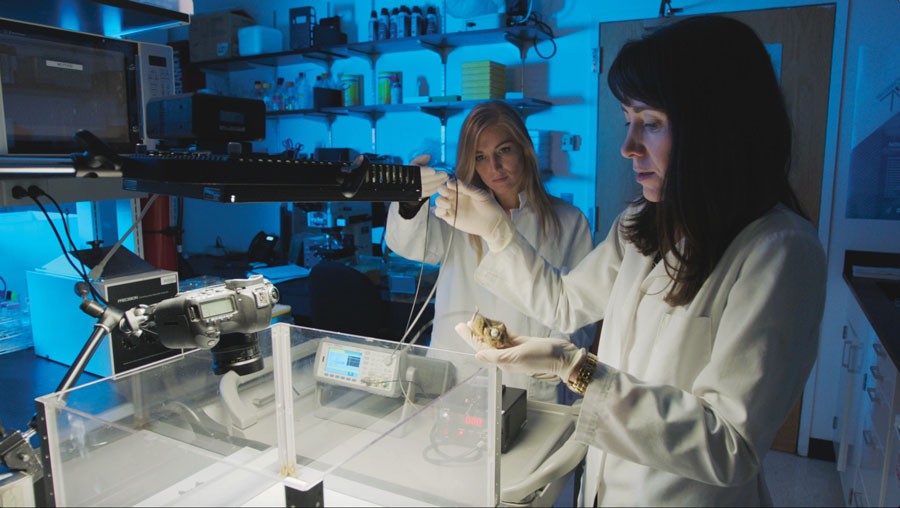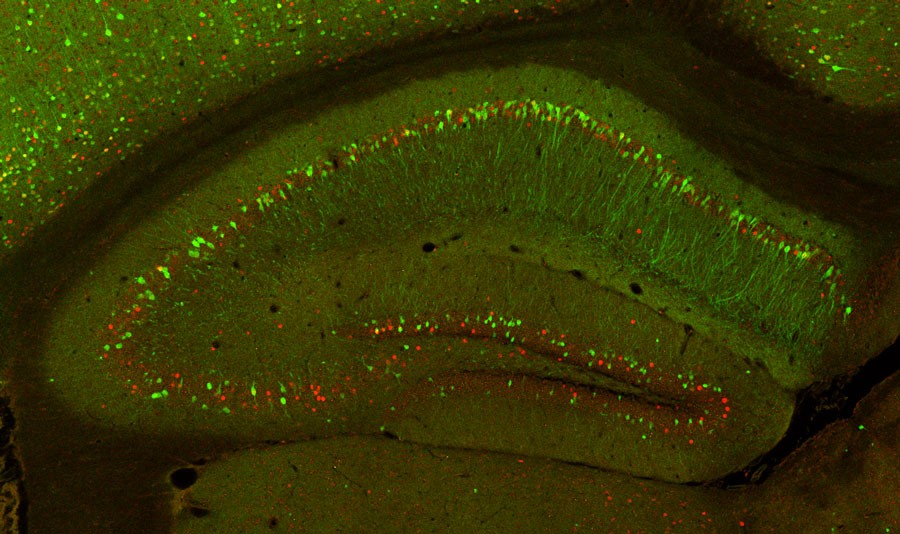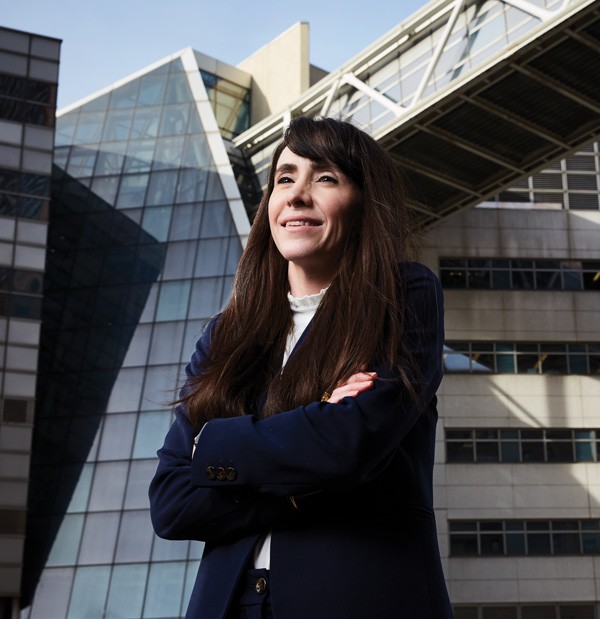
Photo: David Yellen
The Memory Hunter
The pioneering research of neuroscientist Christine Ann Denny ’05, MS'06, could have life-altering implications for people suffering with everything from Alzheimer’s disease to post-traumatic stress disorder.
CHRISTINE ANN DENNY can still remember the first time she set foot on the Boston College campus two decades ago. She was a high school senior on a campus tour, and what sticks in her mind to this day is, of all things, a brochure she was given during the tour. In particular, a photograph in the brochure that captured students on the popular spring-break volunteer trip to Appalachia. Denny ’05, MS'06, ended up attending BC, earning an undergraduate degree in biology and staying to get her master’s in neuroscience. Along the way, she even signed up for the service trip to Appalachia. And, in her memory, it’s all intertwined with that seemingly random photo.
Clearly, seeing the picture was a transformative moment in Denny’s life, and accordingly, her brain recorded the sights, sensations, and emotions associated with it and stored them in a place reserved for major milestones like her wedding day and the births of her two daughters. Of course, like all of us, Denny can also recall the minutiae of seemingly mundane moments from her past. Conversely, some key details from transformative episodes can elude her. Why does the brain retain certain sights, sounds, and smells and let others fade? Perhaps more important, how? What mechanisms are involved in collecting, keeping, and retrieving past sensations and experiences? How does memory work exactly?
These are some of the questions at the core of Denny’s work. A world-renowned researcher and an associate professor at Columbia University Irving Medical Center, she has spent the past fifteen years studying the mechanisms of memory. More precisely, she has made advances, at the molecular level, in uncovering how memories are formed, where in the brain they are stored, and even how they can be triggered and restored. Her work has been nothing short of revolutionary. “Denny and her lab have pioneered a method of being able to turn memories off and on,” said Steve Ramirez, a leading neuroscientist and founder of the Ramirez Group at Boston University’s Center for Systems Neuroscience, who has coauthored papers with Denny. “It’s a huge breakthrough.”
Now Denny has set out to untangle the mysteries of mental ailments that affect millions of people around the world, specifically Alzheimer’s disease and post-traumatic stress disorder (PTSD). And in so doing, she is discovering more than just possible remedies for these devastating conditions. Denny may be unlocking the secrets to our very being.
WHY IS THE HUMAN MIND so often described as a mystery? Because scientifically speaking—despite all of our incredible advances—it still very much is one. Here’s what we do know: When we learn something, anything from a person’s phone number to how to do common core math, neurons in our brains connect to form what are known as synapses—junctions between two nerve cells across which impulses pass. These connections become stronger the more we are exposed to the stimulus (like dialing a familiar phone number or helping our children with math homework), and they tend to weaken when that exposure decreases. That’s why students who drill themselves with anatomy flashcards are better able to recite the bones of the human body, and why it’s difficult to recall the name of the substitute teacher you had one day in 10th grade.
But how does that work? What are the mechanisms involved? Our brain has 100 billion neurons, each connected to 10,000 other neurons, creating trillions and trillions of possible synapses. How is a single memory formed in that vast electrical storm? How and where is it stored in the brain? And how is it retrieved?

Neuroscientist Christine Ann Denny prepares to conduct an experiment with one of her genetically engineered mice. The tiny fiber optics attached to the mouse’s head allow Denny’s team to shine a laser directly into its brain and switch memories off and on. Photo: GBH archives
Such questions lead only to deeper inquiry, and to notions previously reserved for science fiction. For instance, if memories could be located in our brains, would that allow for particularly painful or uncomfortable ones to be erased, as in the 2004 film Eternal Sunshine of the Spotless Mind? Could foreign or manufactured memories be implanted in someone’s brain, as happens in 2010’s Inception? Just a decade after that movie’s release, Denny has been making strides to someday turn these Hollywood fantasies into reality. Which is fitting, in a way, given that the trajectory of Denny’s career is almost cinematic.
When Denny arrived at the Heights, she did not have the benefit of collective memory—she was the first person in her working-class family to go to college. Denny had grown up in New Jersey, where her father drove locomotives for the railroad and her mother was a secretary in the local school system. Denny gravitated toward the sciences, while an ingrained desire to be helpful urged her toward medicine. But first, she needed to get a job during the school year to support herself. And that led her to a meeting with the BC biology professor Thomas N. Seyfried that forever changed her life. “She came in like a ball of fire from the very beginning,” Seyfried said. “I could see right away that she had a lot of talent and ambition. Most students just go through the motions. Christine went well beyond this.”
In Seyfried’s lab, Denny found her path. By the time she was a sophomore, she had turned her focus to biomedical research, with an emphasis on neuroscience and neurodegenerative diseases. Not only was it an area of wide medical interest, but it was also a personal quest for Denny: She, like so many, had family members who suffered from dementia and memory loss. “I had always assumed I’d go to medical school,” she said, “but Seyfried basically told me, ‘You’re really good at being a scientist.’ He saw things in me that I didn’t see in myself. And he was right.”
Denny was a natural at compiling and evaluating data, and also showed a knack for writing clearly and concisely about her work in grant proposals, presentations, papers, and articles for scholarly journals. She coauthored studies with Seyfried and other accomplished academics. In fact, Seyfried said, Denny was getting published in prominent publications more often than many BC faculty members at that time—and she was doing it as an undergrad. Denny could also spot flaws in other scientists’ thinking. Attending meetings and lectures with Seyfried, she would listen to more experienced researchers and quickly discern actual work from the heavy data and dense terminology.
But rather than resent Denny, other students respected her. She looked out for her fellow undergrads, often putting them to work on her experiments in exchange for an author credit on one of her papers. And she was receptive to the help offered by grad students, who seemed drawn to her ability. “People naturally wanted to mentor her,” said Michael Kiebish, who did just that for Denny when he was a biology Ph.D. student at BC in 2002. “When you see that once-in-five-years person, you know you’ll get ten times what you put into them.”
“ Can you block a memory? Can you implant a memory? All of these are interesting questions, but they have important and far-reaching clinical implications. ”
After graduating with a degree in biology in 2005, Denny stayed on at BC for a one-year master’s program. She worked on prominent studies with Seyfried about such topics as caloric restriction and its effects on motor behavior; therapeutic fasting and its impact on health and longevity; neurochemical, morphological, and neurophysiological abnormalities in the retina; and metabolism imbalance in subjects with Huntington’s disease. All of these projects were completed using what would become her favorite collaborators: mice.
Denny spent endless hours working with her furry subjects, mostly on their brains. She designed her own research, built preclinical models, compiled data, and honed her skills with a scalpel, especially in one study on the rodents’ eyes. “Getting a retina out of a mouse is really tough,” Seyfried said. “You have to dissect it under a microscope.”
After earning her master’s in biology in 2006, Denny was accepted the following year into the Ph.D. program at Columbia University. She completed her biological sciences Ph.D. there in 2012, and the following year, she received the National Institutes of Health Director’s Early Independence Award. That allowed her to bypass a postdoctoral fellowship, which helped her start her own lab. She was ready to take her research on the mice’s brains to the next level and delve deeper into the mysteries of the human mind.
TODAY, THE DENNY LABORATORY operates on the seventh floor of Columbia University Irving Medical Center’s Kolb Annex, which is located in the Washington Heights neighborhood of upper Manhattan. Over the past fifteen years, she has genetically engineered a distinct line of mice called ArcCreERT2 mice. These creatures look identical to those you find in a pet store, but their brains have been genetically altered in a way that could unlock the big questions of memory. By modifying the mice’s brains with light-sensitive proteins from algae DNA, Denny’s team can tag neurons that encode individual memories with glowing molecules. This enables them to see, under a microscope, which cells were active when a mouse learned something and which cells were active when it remembered something. In addition, once they’ve labeled a memory, they can switch it off and on with a laser using a technique called optogenetics.
The development of these mice was a scientific feat in itself. And through them, Denny’s lab has produced two separate groundbreaking studies that offer clues about where memories live; whether they are ever truly lost or can be somehow recovered; and whether we can tag and block the ones that are painful and destructive.

This image is of the hippocampus in one of Denny’s genetically engineered mice. It shows the technique she’s developed for tagging the neural cells that build memories in the brain: The green neurons are encoding a fear memory, the red neurons are retrieving that fear memory, and the yellow neurons are where Denny and her team believe the individual memory is located. Photo: Courtesy of Christine Denny
For instance, on a recent day, a mouse cowered beneath a bright white light shining from the corner of an otherwise empty plexiglass cage. The creature, scared of an environment it had never experienced before, had nowhere to run to, no hole or shadow to hide in. But then, Denny flipped a switch and the mouse suddenly shed all fear. It started moving confidently around the space, feeling comfortable enough to pause and groom itself.
Denny’s “switch” turned on a laser that shot through a fiber-optic line gently connected to the top of the mouse’s head. The day before, this same mouse had been injected with a drug that, essentially, lit up its neurons as they were activated, enabling Denny to tag the neurons that would store the memory of the experience this mouse was about to have. The mouse was then placed in a comforting habitat, dim and shadowy with plenty of soft, snug places to burrow. It was a pleasant experience, and Denny recorded the memory of it. So, when she flipped her switch as the same mouse cowered in the bright cage, what she was really doing was locating and activating that good memory in the mouse’s brain, thereby overriding its fear. “Can you block a memory?” Denny asked. “Can you implant a memory? All of these are interesting questions, but they have important and far-reaching clinical implications.”
DENNY'S RESEARCH OPENS UP a universe of possibilities for scientists working to better understand the mechanics of human memory. For now, though, Denny and her team are focusing their efforts on two important fronts: Alzheimer’s disease and the dulling, blocking, and even prevention of traumatic memories.
An estimated 5.8 million Americans, including one in ten people 65 and older, currently live with Alzheimer’s. For decades, doctors have believed that the disease destroys memory-storing neurons, effectively wiping our memories clean. But Denny’s research on her ArcCreERT2 mice suggests otherwise. In a 2017 experiment, Denny’s team took two groups of mice—one healthy, the other with an Alzheimer’s-like disease—and engineered their neurons to glow yellow. Both sets of mice were given a lemon scent, followed quickly by an electric shock. A week later, the same mice were again given the lemon scent. The healthy creatures understandably braced for the ensuing zap, but those with the disease did so only about half as often, their minds seemingly failing to make the connection. The researchers, observing what was going on inside each mouse’s brain, saw neurons glow yellow when the electric-shock memory was stored, and red when the memory was retrieved. In the healthy mice, the yellow and red overlapped, meaning they were pulling the correct memory from the mental shelf. Many of the Alzheimer’s mice, however, didn’t recall the memory, even though that memory, colored yellow, was still present in their brain. But it was what Denny and her team did next that was truly innovative. The researchers used their laser to reactivate the yellow neurons, causing the diseased mice to remember and brace for the shock.
All of which raises the possibility that Alzheimer’s doesn’t completely delete memories, but rather interferes with the retrieval process. And if a memory isn’t so much lost as it is misplaced or miscategorized, then an entire lifetime of memories once thought to be ravaged by the disease might actually be salvageable.

Another ongoing area of work coming out of the Denny Lab involves traumatic memories. In one study, Denny gave some of the ArcCreERT2 mice ketamine—a prescription anesthetic—and others saline, and then exposed both groups to a series of stressors. The ketamine-dosed mice demonstrated far fewer outward signs of fear, as well as a differential activation of fear-associated neurons. That led Denny and her team to surmise that the drug could be used to prevent the creation of traumatic memories or even to lessen the severity of existing fear memories—the latter finding a potential salve for PTSD patients and other people dealing with stress-induced disorders. “This research could have huge implications,” said Kiebish, Denny’s onetime mentor at BC who is now chief precision medicine officer at the biotech firm BERG, and has been a coauthor on some of Denny’s ketamine studies. The anesthetic “seems to have a very strong effect on post-traumatic stress if given prophylactically. And we’re talking about hundreds of millions of people around the world affected by PTSD and anxiety. It’s really inventive research.”
Steven A. Siegelbaum, chair of the neuroscience department at Columbia University, agrees. “She’s provided a new way of thinking about PTSD,” he said of Denny. “She’s provided a clue as to what goes wrong when you generalize fearful experiences and opened up a whole range of ways of identifying which neurons are important for which particular functions. She’s dissecting it at a cell-by-cell level: Which cells are important for particular behavior? Which might be altered in disease?”
AS EXCITING AS DENNY'S experiments are, there’s a big difference between working with a mouse and a person. While using optogenetics on human subjects is still probably in the distant future, what Denny and her team have uncovered in just over a decade is helping us better understand how our minds function. In the near term, she’s looking at whether memory types are grouped together in the brain. In other words, are all negative memories stored in one area, and all positive ones in another? And she’s received another grant from the NIH to tackle a new Alzheimer’s project. By observing how mice behave at different times of day, Denny will explore the neural groupings that might impact agitation and increased anxiety in patients during the evening hours, otherwise known as sundowning.
Meanwhile, there is optimism about Denny’s research into whether ketamine and similar drugs could block traumatic memories and prevent or ease PTSD. Many scientists and developers are expanding on Denny’s work to find resilience-enhancing drugs that could help everyone from military troops in combat to women suffering from postpartum depression. One day, Denny hopes, another researcher might build on her mouse model to develop a prophylactic for physical as well as emotional pain. “The beauty of the work she’s doing is that it is both invasive and noninvasive,” said Ramirez, the BU neuroscientist. “Right now, the drugs we use to treat mental disorders flood the entire brain, but she is developing more targeted approaches. Perhaps in the future we’ll be able to inject a drug that crosses the blood/brain barrier or even use deep brain stimulation. She’s helping us pin down the mechanisms of the memory—and it’s a promising avenue.”
And that might be Denny’s most important legacy—mapping the human mind and our memory to help us not only understand how to block and retrieve memories, but also to learn why and how we remember. In a sense, it’s the study of who we are. “When someone loses their memory, they lose themselves,” Denny said. “There’s so much we don’t know about it. Your memory is basically you—who you are as a soul. Your memories give meaning to your life.” 
Tony Rehagen is a writer based in St. Louis. His writing has appeared in GQ, Popular Mechanics, and ESPN The Magazine.


 print
print mail
mail